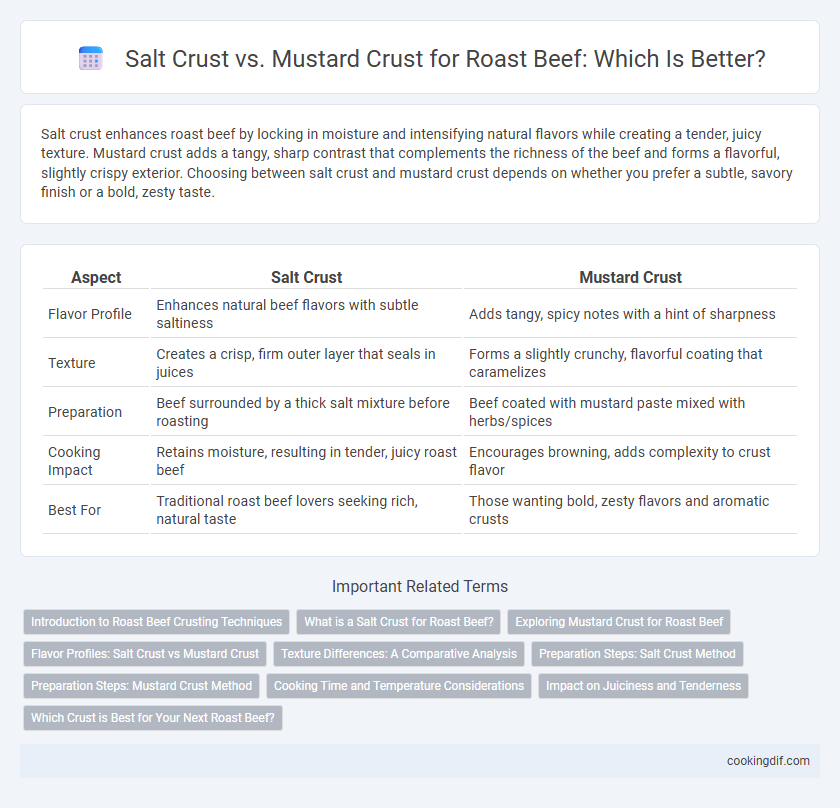Salt crust enhances roast beef by locking in moisture and intensifying natural flavors while creating a tender, juicy texture. Mustard crust adds a tangy, sharp contrast that complements the richness of the beef and forms a flavorful, slightly crispy exterior. Choosing between salt crust and mustard crust depends on whether you prefer a subtle, savory finish or a bold, zesty taste.
Table of Comparison
| Aspect | Salt Crust | Mustard Crust |
|---|---|---|
| Flavor Profile | Enhances natural beef flavors with subtle saltiness | Adds tangy, spicy notes with a hint of sharpness |
| Texture | Creates a crisp, firm outer layer that seals in juices | Forms a slightly crunchy, flavorful coating that caramelizes |
| Preparation | Beef surrounded by a thick salt mixture before roasting | Beef coated with mustard paste mixed with herbs/spices |
| Cooking Impact | Retains moisture, resulting in tender, juicy roast beef | Encourages browning, adds complexity to crust flavor |
| Best For | Traditional roast beef lovers seeking rich, natural taste | Those wanting bold, zesty flavors and aromatic crusts |
Introduction to Roast Beef Crusting Techniques
Salt crusting enhances roast beef by sealing in juices and intensifying natural flavors through a mineral-rich barrier, creating a tender, succulent texture. Mustard crusting introduces a tangy, spicy layer that caramelizes during roasting, adding complex depth and a crisp exterior. Both techniques elevate roast beef by balancing moisture retention and flavor development, catering to distinct palate preferences.
What is a Salt Crust for Roast Beef?
A salt crust for roast beef involves encasing the meat in a thick layer of coarse salt mixed with herbs and sometimes egg whites to create a hard shell that locks in moisture and enhances flavor. This method ensures even cooking and tender results by insulating the beef from direct heat, preserving its natural juices. The salt crust is typically cracked open before serving, leaving the roast flavorful without being overly salty.
Exploring Mustard Crust for Roast Beef
Mustard crust for roast beef creates a flavorful, tangy exterior that enhances the natural richness of the meat while helping to lock in moisture during cooking. The combination of Dijon mustard, herbs like rosemary and thyme, and breadcrumbs forms a savory, slightly crispy layer that contrasts perfectly with tender, juicy beef. Unlike salt crusts, mustard crusts impart a subtle zest, adding complexity without overpowering the roast's robust beef flavor.
Flavor Profiles: Salt Crust vs Mustard Crust
Salt crust enhances roast beef by intensifying natural meat flavors and creating a savory, evenly seasoned exterior that locks in moisture for tender results. Mustard crust adds a tangy, sharp layer with aromatic spices that complement the beef's richness, offering a zesty and slightly pungent taste. Choosing between salt crust and mustard crust depends on whether a pure, salty depth or a bold, flavorful punch is preferred for the roast beef.
Texture Differences: A Comparative Analysis
Salt crust creates a crisp, flaky outer layer that locks in moisture, resulting in tender, juicy roast beef with a pronounced savory crust. Mustard crust forms a rich, slightly tangy, and softer exterior that enhances flavor without adding significant crunch. Texture differences highlight salt crust's crunchiness versus mustard crust's creamy, flavorful coating, influencing the roast beef's mouthfeel and overall eating experience.
Preparation Steps: Salt Crust Method
The salt crust method for roast beef involves coating the entire joint with a thick layer of coarse sea salt mixed with egg whites to form a firm crust that locks in moisture and flavor during cooking. Before applying the salt crust, the beef should be dried thoroughly and seasoned lightly with herbs or spices as desired. The roast is then baked with the salt crust intact, which is cracked and removed just before serving to reveal a tender, juicy interior.
Preparation Steps: Mustard Crust Method
To prepare a mustard crust for roast beef, spread a generous layer of Dijon or wholegrain mustard evenly over the surface of the beef before seasoning with salt and herbs. The mustard acts as a flavorful adhesive, helping herbs, garlic, and breadcrumbs to stick and form a flavorful crust during roasting. This method enhances the roast beef's taste and texture by creating a tangy, aromatic crust that locks in moisture.
Cooking Time and Temperature Considerations
Salt crust for roast beef requires a moderate oven temperature around 350degF (175degC), typically extending cooking time by 10-15% to ensure even heat penetration while preserving moisture. Mustard crust, benefiting from the crust's flavorful sear, allows slightly higher temperatures of 375degF (190degC) and shorter cooking times without drying the meat, thanks to its caramelizing properties. Both methods require careful monitoring of internal temperature, aiming for 130-135degF (54-57degC) for medium-rare doneness.
Impact on Juiciness and Tenderness
Salt crust enhances the juiciness of roast beef by creating a sealed environment that locks in moisture during cooking, resulting in tender and succulent meat. Mustard crust, rich in acidity and enzymes, tenderizes the beef's fibers while adding a flavorful layer, but can sometimes draw out moisture if applied too thickly. Balancing the salt crust's moisture retention with mustard's tenderizing properties offers a flavorful, juicy, and tender roast beef experience.
Which Crust is Best for Your Next Roast Beef?
Salt crust enhances roast beef by sealing in moisture and intensifying natural flavors through a mineral-rich barrier, creating a tender and juicy result. Mustard crust adds a tangy, sharp layer that caramelizes during roasting, providing a bold, flavorful crust with a rich, savory crust that complements the beef's umami. Choosing between salt crust and mustard crust depends on whether you prefer a pure beef flavor with enhanced juiciness or a vibrant, seasoned exterior for your roast beef.
Salt Crust vs Mustard Crust for Roast Beef Infographic

 cookingdif.com
cookingdif.com